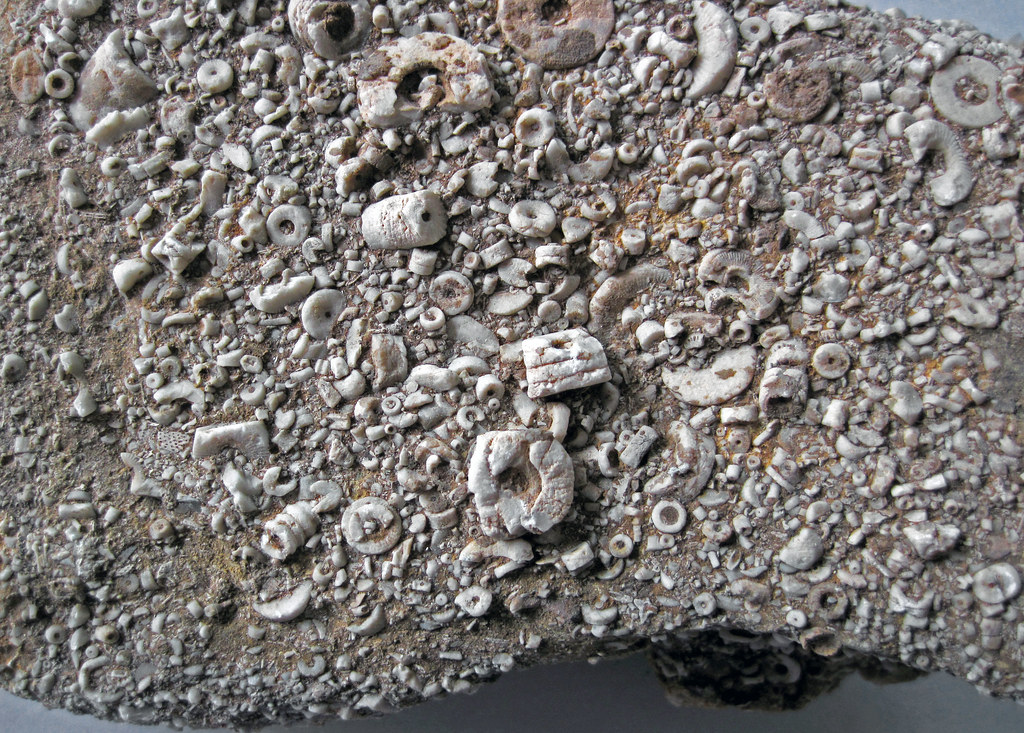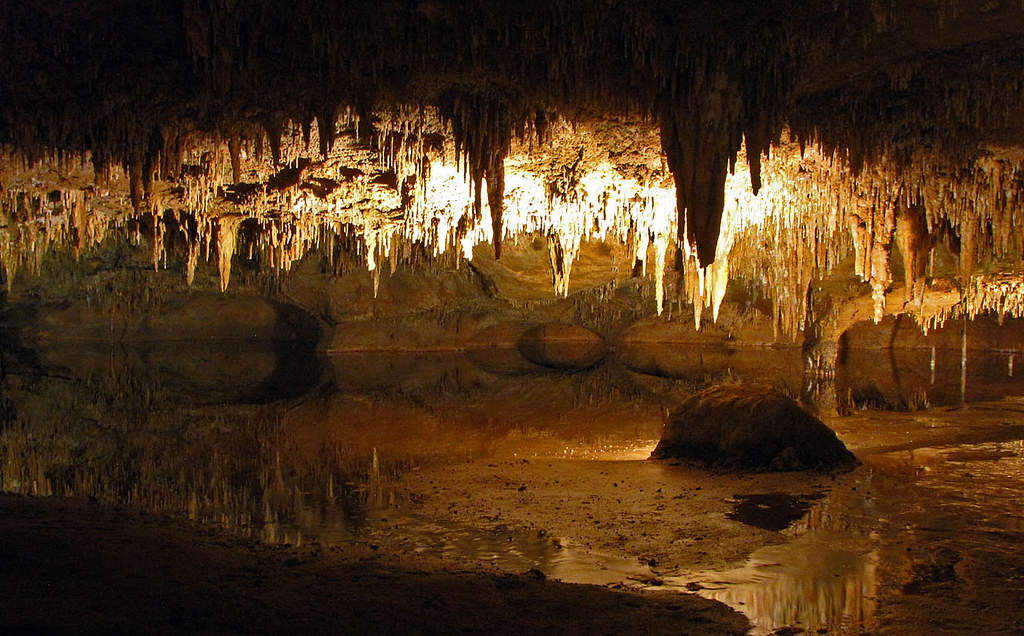Limestone is a sedimentary rock, formed from small pressurized particles of rocks and stones. Sedimentary rocks are important because they often contain fossils that give us indications about past ages.

Image source: https://search.creativecommons.org/photos/d317b649-d8b0-4dfa-8e6b-53a1bf806635 by Bernard Spragg
What is limestone?
Limestone is a sedimentary rock consisting of 50% of calcium carbonate (CaCO3) in the mineral calcite form. Its origins can be traced back to either chemical or biochemical processes that occurred in the past (hundreds of millions of years ago). It usually forms in clear, warm, shallow marine waters from the accumulation of shell, coral, algal, and fecal debris. However, it can also be formed by the precipitation of calcium carbonate from lake or ocean water. Because it is often formed from shells or bones, it has a light tone color like white, tan, or grey. Therefore, its color is influenced by sediments in the mixture.

Image source: https://search.creativecommons.org/photos/35805947-dbc9-461f-9fe4-1bb8dec19f9d by Bernard Spragg
How is limestone Formed?
It can be formed in two ways: by the accumulation of living organisms and by evaporation. Most limestones come from marine deposits, but some are formed in lakes, rivers, and on land. When the organisms die, their shells are left on the ocean floor, lake bottom, or river bed where they accumulate into deposits.
Earth has many limestone-forming settings: most of them are found in shallow water, for example in the Caribbean Sea, Indian Ocean, Persian Gulf, Gulf of Mexico, and around Pacific Ocean islands.
-
- Crinoidal Limestones: Crinoids are sea animals that had long stems, cup-like bodies that look like flowers, and for this reason, called sea lilies. The stems break into small, disc-shaped fragments. These are found extensively in eastern Kansas and Pennsylvania.
- Fusilinid Limestones: Fusilinid is one of the single-celled animals called Foraminifera. These small animals, whose shells look like wheat grains, formed these kinds of limestones.
- Reef-like Limestones and Shell Limestones: These limestones contain the remains of corals, brachiopods, clams, oysters, bryozoans, and other forms. These deposits sometimes grow to several hundred miles in length.

Image source: https://search.creativecommons.org/photos/94584f72-c9b9-4280-94d6-c47dba71e43f by James St. John
Limestone can also form through evaporation. Stalactites, stalagmites, and other cave formations (often called “speleothems“) are examples of limestone formed through evaporation. In a cave, droplets of water seeping down from above enter the cave through fractures or other pore spaces in the cave ceiling. There they might evaporate before falling to the cave floor. Over time, this evaporative process can result in an accumulation of icicle-shaped calcium carbonate on the cave ceiling that forms stalactites. If the droplet falls to the floor and evaporates there, it forms stalagmites that could grow upwards from the cave floor.

Image source: https://search.creativecommons.org/photos/450d6bd3-44db-4dc0-807a-4334916ee8e9 by scott1346
Types of limestone
There are many different names used for limestone. These names are based upon how the rock formed, its appearance, and its composition.
- Chalk: A soft limestone with fine texture, generally white or light grey. It is formed usually from the calcareous shell remains of microscopic marine organisms.
- Coquina: It is composed mainly of broken shell debris, formed on beaches where wave action fragment shells.
- Fossiliferous Limestone: contains abundant fossils, normally shell and skeletal fossils of the organisms.
- Lithographic Limestone: A dense limestone with a uniform grain size which is a very smooth surface.
- Oolitic Limestone: is composed mainly of calcium carbonate “oolites,” small spheres formed by the concentric precipitation of calcium carbonate on a sand grain or shell fragment.
- Travertine: A limestone formed through evaporation, often in a cave (stalactites, stalagmites, and flowstone).
- Tufa: produced by the precipitation of calcium-laden waters at a hot spring, lakeshore, or other settings.

Image source: https://search.creativecommons.org/photos/334d6002-1f18-41f7-8af7-6e0d5fd3dfaa by James St. John
How was it used throughout history?
Nobody knows exactly when humans first discovered limestone, however, Lime foundations in eastern Turkey show that this was already being used 14,000 years ago. Earlier still, the Lascaux caves in France feature frescoes of natural iron oxide pigments applied to damp cave walls of high calcium content dating back as far as 16,000 years that were also used to build the pyramids in Egypt. And Romans even would mix limestone with volcanic ash to form a type of material for building.

image source: https://search.creativecommons.org/photos/e43415cc-a443-46ad-a213-aaa3dd3e53f6 by subarcticmike
Some limestone usage key dates:
-
- c. 7500 BC. The ancient people who lived in Jordan, made plaster from lime to cover walls, floors, and hearths in their homes.
- c. 3000 BC. The Egyptians built one of the limestone wonders of the world: the Cheops pyramid.
- Lime colors were founded in Greek frescos.
- 500 BC. The Chinese built the 2,500 km Great Wall and used lime mortars to cement the stones together.
- 753 B.C. – 535 A.D. Roman frescos and buildings featured different lime colors. Women colored their hair to a light red hue with unslaked lime.
- 16th Century Lime usage increased with evolutions in building and different types of structures.
- 17th Century develops The Scagliola technique as a substitute for marble inlays. It consisted of a pigmented mixture of lime dust. It was also used to create building facades, stucco columns, sculptures, and other architectural elements.
- 18th& 19th Centuries Debray and Lechatelier discovered others qualities and applications of lime. For example, limestone was used for the first time as an ingredient in toothpaste.
- 20th and 21st Centuries. The rapid development of technologies expanded the use of lime, which is why today we encounter lime in lots of usages.
Because it is easily carved, Limestone nowadays appears in many buildings, such as in the Empire State Building in New York City and on the U.S. Holocaust Memorial and Museum in Washington D.C.

image source: https://search.creativecommons.org/photos/b35340f2-1014-4814-acce-ca73ff37cb74 by ★ SimonPix

Image source: https://search.creativecommons.org/photos/61a4caa2-7d4e-423d-8eaf-cde63513b437 by budgetplaces.com
Where it can be found today?
Important uses of limestone also include:
- Dimension Stone: Limestone is often cut into blocks of specific dimensions for building. It is used for facing stone, floor tiles, stair treads, window sills, and many other occasions.
- Roofing Granules: Crushed to fine particle size, limestone is used as a weather and heat-resistant coating on asphalt-impregnated shingles and roofing. It is also used as a topcoat on built-up roofs.
- Flux Stone: Crushed limestone is even used in fusion and other metal refining processes.
- Portland Cement: Limestone is heated in a kiln with other materials and crushed in a powder that will harden after being mixed with water.
- AgLime: Crushed to sand-size or smaller particles, limestone becomes a useful material for treating acidic ground. It is also used on farms all over the world.
- Lime: If calcium carbonate (CaC03) is heated to high temperature in a kiln, it produces carbon dioxide gas (CO2) and calcium oxide (CaO) which are used as an acid-neutralization for soil treatment in agriculture.
- Animal Feed Filler: Chickens need calcium carbonate to produce strong eggshells, which is why it is often given to them as a dietary supplement in the form of “chicken grits.” Moreover, calcium is also given to some dairy cattle who must replace large amounts of calcium lost during the milking process.
- Mine Safety Dust: Pulverized limestone is a white powder that can be sprayed onto surfaces of an underground mine. This dust improves illumination and reduces the amount of coal dust that comes up in the activity. In this way, it improves the breathed air and reduces the risk of explosion produced by suspended particles of flammable coal dust in the air.
- Limestone has many other uses; for instance in paper, paint, rubber, plastic, and as a sorbent of pollutants.

image source: http://geology.com/usgs/limestone/
Info sources:
http://geology.com/rocks/limestone.shtml
https://www.irvmat.com/kids/whatIsLimestone.htm
http://sciencelearn.org.nz/Contexts/A-Fizzy-Rock/Science-Ideas-and-Concepts/Limestone-origins
